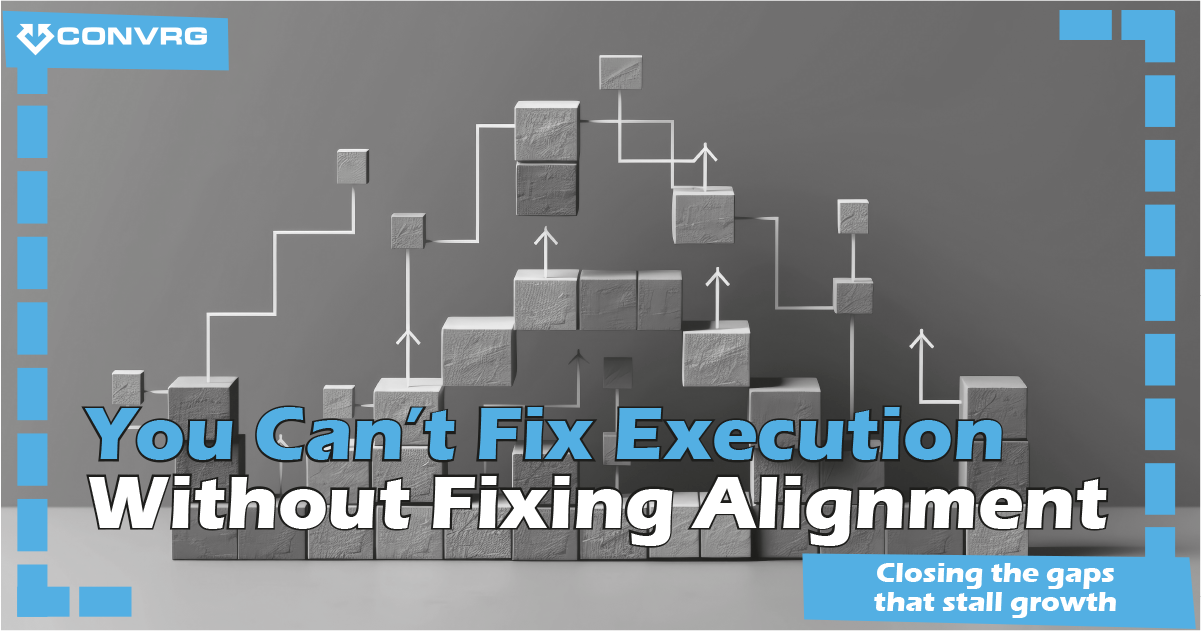Why your CRM isn’t working – and it’s not the system’s fault
It’s Not a Tool Problem. It’s a Leadership Problem.
You’ve rolled out the CRM.
You’ve mapped the processes.
You’ve trained the team.
And yet…
- Sales aren’t logging activity.
- Marketing is frustrated with the data.
- Ops is working around the system again.
- Reports can’t be trusted.
Sound familiar?
You’re not alone. This is one of the most common patterns we see in scaling B2B firms. And the instinct is always the same:
“We need to retrain the team.”
“We need a new workflow.”
“We just need better dashboards.”
But none of those things fix the real issue. Because the real issue isn’t technical – it’s organisational.
You don’t have an execution problem. You have an alignment problem.
What Alignment Actually Means
Let’s clear something up: alignment isn’t just about everyone nodding in the same meeting.
Alignment means that every function in your business is pulling toward the same outcome – with clarity, accountability, and system support.
It shows up in:
- Shared goals that cascade from strategy to delivery
- Teams that co-own outcomes, not just tasks
- A CRM that reflects how your business actually works
- Meetings that drive action – not confusion
- Metrics that matter to more than one team
Without this kind of alignment, execution becomes fractured.
And that’s when your CRM – and your growth strategy – starts to break.
The CRM Playbook That Never Got Run
We see it over and over:
- The business invests in HubSpot (or another platform).
- Strategy sessions define bold growth objectives.
- Functional leads build the CRM workflows in silos.
- Teams are trained – briefly.
- A few weeks later… nothing sticks.
You check the CRM adoption dashboard and see:
- Custom properties never filled in
- Lead stages inconsistent
- Sales using spreadsheets “just to be safe”
- Marketing sending campaigns from lists no one trusts
What went wrong?
There was no cross-functional alignment to begin with.
You tried to build execution on top of misalignment – and it collapsed.
The Invisible Link Between Leadership and Execution
We’ve worked with dozens of businesses that were stuck in this loop:
Growth strategy → Tools rollout → Poor adoption → Rebuild → Repeat.
In every case, the core issue wasn’t the platform.
It was the lack of alignment between leadership, teams, and systems.
Here’s what that misalignment often looks like:
|
Level |
Symptoms of Misalignment |
|
Leadership |
Competing priorities, siloed OKRs, no shared narrative for growth |
|
Middle Management |
Functional leads own processes in isolation, no visibility of end-to-end performance |
|
Frontline Teams |
Conflicting expectations, unclear handoffs, low trust in systems and reporting |
When leaders aren’t aligned, teams can’t be aligned.
And if teams aren’t aligned, your systems won’t stick – no matter how well they’re set up.
Why Execution Fails Without Alignment
Execution isn’t just about activity.
It’s about orchestrated action that moves the business forward.
Without alignment, what you get is:
- Redundant effort – teams duplicating work or stepping on each other’s toes
- Slowed momentum – every initiative needs extra clarification or gets stuck in approvals
- Missed opportunities – data is siloed, insights delayed, handoffs missed
- Overstretched leadership – dragged into firefighting instead of leading strategy
And most dangerously: you start losing confidence in your own strategy.
The SIMPLIFI Approach: Lead Alignment First
At CONVRG, we help businesses fix broken execution by starting where it matters most – leadership alignment.
Before we touch workflows or automation, we ask:
- Are you agreed on what success looks like?
- Are you aligned on how to measure it?
- Are your teams set up to deliver that vision across functions?
That’s what the SIMPLIFI Framework is designed to do – align strategy, systems, and execution around a clear operating model for growth.
In the Execution phase, we map this through what we call the Execution Ladder – a structured approach to move from vision to action.
But it all starts with this: alignment is a leadership responsibility.
You can’t delegate it to your CRM Admin or your RevOps lead.
The First Signs of Misalignment in CRM
Here are some real-world red flags that you’ve got an alignment issue – not a tech issue:
- Sales says: “Marketing leads aren’t qualified.”
→ But there’s no agreed scoring or SLA. - Marketing says: “Sales never follows up.”
→ But there’s no workflow visibility or shared metrics. - Ops says: “The CRM doesn’t reflect how we actually work.”
→ Because no one involved them in the design. - Leadership says: “Why can’t we get one version of the truth?”
→ Because there’s no system-wide data strategy.
These aren’t workflow problems. They’re symptoms of disconnected decision-making.
So What Does Real Alignment Look Like?
Here’s what we help our clients build:
|
Aligned Organisation |
Disjointed Organisation |
|
Shared strategic narrative |
Functional silos with separate goals |
|
Cross-functional system ownership |
CRM owned by one team (often Marketing) |
|
Joint KPI dashboards |
Each team builds their own reports |
|
Consistent rhythms (reviews, standups) |
Sporadic updates and email catchups |
|
Clear decision-making & escalation |
Everything routes back to the C-suite |
In aligned businesses, CRM adoption improves organically – because it reflects how the business actually works together.
Alignment Before Execution: A Real-World Shift
One of our recent clients came to us with a “CRM adoption issue.”
Sales didn’t trust the data.
Marketing had no visibility.
Reporting was a mess.
They’d tried retraining.
They’d hired external automation consultants.
They’d even rebuilt the funnel logic.
Nothing worked.
So we paused. And we asked:
- What’s the shared goal?
- Who owns each part of the journey?
- How are decisions made?
- Is the CRM designed around how you want to work – or how it’s easiest to set up?
Within 6 weeks of re-aligning the leadership team and remapping their core systems around shared goals, the entire operating rhythm changed.
CRM usage surged. Forecast accuracy improved. Teams finally felt like they were playing the same game.
Because we stopped trying to fix the tool – and fixed the alignment instead.
How to Start Realigning Your Organisation
This doesn’t need to be a six-month project.
But it does require leadership focus.
Start with these 3 simple actions:
- Run a 60-Minute Leadership Retro
Ask: Are we aligned on what matters, what’s working, and where we’re stuck?
(Use our free “Leadership Retro Guide” to facilitate this.)
- Review System Ownership
List your key CRM processes. Who owns them? Who should?
Are Marketing, Sales, and Ops working together – or in parallel?
- Download the 7 Growth Gaps Lead Magnet
Identify the deeper execution blockers across your strategy, systems, and teams – and get a roadmap to fix them.
Download the 7 Growth Gaps Quietly Holding You Back
Final Word: You Can’t Execute Alone
Execution is hard.
But what makes it harder – and more frustrating – is trying to drive it without alignment.
Fixing execution doesn’t start with systems.
It starts with shared direction. With cross-functional accountability. With leadership consistency.
Because the moment you align your organisation is the moment your strategy becomes real – and your CRM starts to deliver what it promised all along.





.png)
.jpg)